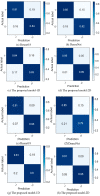Atrial Fibrillation Prediction Based on Recurrence Plot and ResNet
- PMID: 39124025
- PMCID: PMC11314825
- DOI: 10.3390/s24154978
Atrial Fibrillation Prediction Based on Recurrence Plot and ResNet
Abstract
Atrial fibrillation (AF) is the most prevalent form of arrhythmia, with a rising incidence and prevalence worldwide, posing significant implications for public health. In this paper, we introduce an approach that combines the Recurrence Plot (RP) technique and the ResNet architecture to predict AF. Our method involves three main steps: using wavelet filtering to remove noise interference; generating RPs through phase space reconstruction; and employing a multi-level chained residual network for AF prediction. To validate our approach, we established a comprehensive database consisting of electrocardiogram (ECG) recordings from 1008 AF patients and 48,292 Non-AF patients, with a total of 2067 and 93,129 ECGs, respectively. The experimental results demonstrated high levels of prediction precision (90.5%), recall (89.1%), F1 score (89.8%), accuracy (93.4%), and AUC (96%) on our dataset. Moreover, when tested on a publicly available AF dataset (AFPDB), our method achieved even higher prediction precision (94.8%), recall (99.4%), F1 score (97.0%), accuracy (97.0%), and AUC (99.7%). These findings suggest that our proposed method can effectively extract subtle information from ECG signals, leading to highly accurate AF predictions.
Keywords: ECG; Recurrence Plot; ResNet; atrial fibrillation; prediction.
Conflict of interest statement
The authors declare no competing interests.
Figures













References
-
- Tsigkas G., Apostolos A., Despotopoulos S., Vasilagkos G., Kallergis E., Leventopoulos G., Mplani V., Davlouros P. Heart failure and atrial fibrillation: New concepts in pathophysiology, management, and future directions. Heart Fail. Rev. 2022;27:1201–1210. doi: 10.1007/s10741-021-10133-6. - DOI - PubMed
-
- Kumar D., Puthusserypady S., Dominguez H., Sharma K., Bardram J.E. An investigation of the contextual distribution of false positives in a deep learning-based atrial fibrillation detection algorithm. Expert. Syst. Appl. 2023;211:118540. doi: 10.1016/j.eswa.2022.118540. - DOI
MeSH terms
Grants and funding
- LQ22F010006/Zhejiang Provincial Natural Science Foundation of China
- LGF20H150006/Basic Public Welfare Research Project of Zhejiang Province
- No. 81971688/National Natural Science Foundation of China
- No. 2020386297/Medical and Public Health Projects in Zhejiang Province
- 20032311-Y/Science Foundation of Zhejiang Sci-Tech University (ZSTU)
LinkOut - more resources
Full Text Sources
Medical

